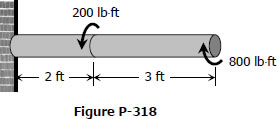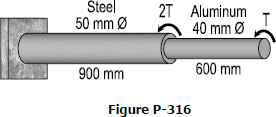Solution to Problem 324 Torsion
Problem 324
The compound shaft shown in Fig. P-324 is attached to rigid supports. For the bronze segment AB, the maximum shearing stress is limited to 8000 psi and for the steel segment BC, it is limited to 12 ksi. Determine the diameters of each segment so that each material will be simultaneously stressed to its permissible limit when a torque T = 12 kip·ft is applied. For bronze, G = 6 × 106 psi and for steel, G = 12 × 106 psi.
- Read more about Solution to Problem 324 Torsion
- Log in to post comments
Solution to Problem 323 Torsion
Problem 323
A shaft composed of segments AC, CD, and DB is fastened to rigid supports and loaded as shown in Fig. P-323. For bronze, G = 35 GPa; aluminum, G = 28 GPa, and for steel, G = 83 GPa. Determine the maximum shearing stress developed in each segment.
- Read more about Solution to Problem 323 Torsion
- Log in to post comments
Solution to Problem 322 Torsion
Problem 322
A solid steel shaft is loaded as shown in Fig. P-322. Using G = 83 GPa, determine the required diameter of the shaft if the shearing stress is limited to 60 MPa and the angle of rotation at the free end is not to exceed 4 deg.
- Read more about Solution to Problem 322 Torsion
- Log in to post comments
Solution to Problem 320 Torsion
Problem 320
In Prob. 319, determine the ratio of lengths b/a so that each material will be stressed to its permissible limit. What torque T is required?
- Read more about Solution to Problem 320 Torsion
- 2 comments
- Log in to post comments
Solution to Problem 319 Torsion
Problem 319
The compound shaft shown in Fig. P-319 is attached to rigid supports. For the bronze segment AB, the diameter is 75 mm, τ ≤ 60 MPa, and G = 35 GPa. For the steel segment BC, the diameter is 50 mm, τ ≤ 80 MPa, and G = 83 GPa. If a = 2 m and b = 1.5 m, compute the maximum torque T that can be applied.
- Read more about Solution to Problem 319 Torsion
- Log in to post comments
Derivation of the Double Angle Formulas
The Double Angle Formulas can be derived from Sum of Two Angles listed below:
$\sin (A + B) = \sin A \, \cos B + \cos A \, \sin B$ → Equation (1)
$\cos (A + B) = \cos A \, \cos B - \sin A \, \sin B$ → Equation (2)
$\tan (A + B) = \dfrac{\tan A + \tan B}{1 - \tan A \, \tan B}$ → Equation (3)
- Read more about Derivation of the Double Angle Formulas
- Log in to post comments
Solution to Problem 318 Torsion
Problem 318
A solid aluminum shaft 2 in. in diameter is subjected to two torques as shown in Fig. P-318. Determine the maximum shearing stress in each segment and the angle of rotation of the free end. Use G = 4 × 106 psi.

- Read more about Solution to Problem 318 Torsion
- 1 comment
- Log in to post comments
Solution to Problem 317 Torsion
Problem 317
A hollow bronze shaft of 3 in. outer diameter and 2 in. inner diameter is slipped over a solid steel shaft 2 in. in diameter and of the same length as the hollow shaft. The two shafts are then fastened rigidly together at their ends. For bronze, G = 6 × 106 psi, and for steel, G = 12 × 106 psi. What torque can be applied to the composite shaft without exceeding a shearing stress of 8000 psi in the bronze or 12 ksi in the steel?
- Read more about Solution to Problem 317 Torsion
- 2 comments
- Log in to post comments
316 Permissible Torque That Can Be Applied to a Compound Shaft
Problem 316
A compound shaft consisting of a steel segment and an aluminum segment is acted upon by two torques as shown in Fig. P-316. Determine the maximum permissible value of T subject to the following conditions: τst ≤ 83 MPa, τal ≤ 55 MPa, and the angle of rotation of the free end is limited to 6°. For steel, G = 83 GPa and for aluminum, G = 28 GPa.



Recent comments
(…